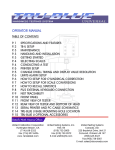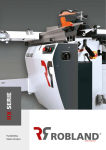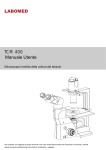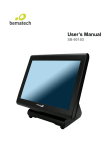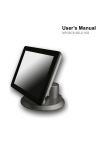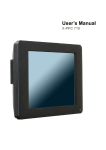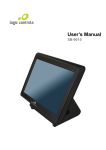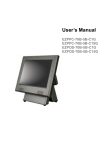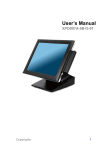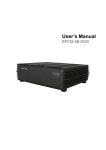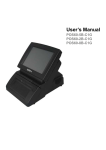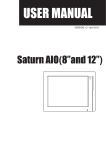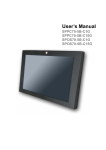Download ITR-CS15D User Manual
Transcript
User’s Manual ITR-CS15D ITR-CS15D Copyrights ©2012 TALOS INTEGRATED TECHNOLGIES. All rights reserved. The information in this document is subject to change without prior notice in order to improve reliability, design and function and does not represent a commitment on the part of the manufacturer. Safety Statement for Lithium Battery This document contains proprietary information protected by copyright. All rights are reserved. No part of this manual may be reproduced by any mechanical, electronic, or other means in any form without prior written permission of the manufacturer. CAUTION RISK OF EXPLOSION IF BATTERY IS REPLACED BY AN INCOORECT TYPE. DISPOSE OF USED BATTERIES ACCORDING TO THE INSTRUCTIONS All trademarks are property of their respective owners Liability Disclaimer In no event will the manufacturer be liable for direct, indirect, special, incidental, or consequential damages arising out of the use or inability to use the product or documentation, even if advised of the possibility of such damages. TALOS INTEGRATED TECHNOLOGIES 411 BRADWICK DR. UNIT# 11 VAUGHAN, ONTARIO L4K 2P4 Regulatory Information FCC Notices Copyrights i ITR-CS15D Contents Copyrights .................................................................................................i Liability Disclaimer ...................................................................................i Regulatory Information.............................................................................i FCC Notices.......................................................................................................... i Safety Statement for Lithium Battery ......................................................i Contents....................................................................................................ii 1. Hardware Setup....................................................................................4 1.1. Packing Contents ......................................................................................... 4 1.2. Quick Tour .................................................................................................... 5 Front View and Side View .............................................................................. 5 Back Panel I/O ............................................................................................... 6 1.3. HDD Replacement ........................................................................................ 6 1.4. Basic Peripherals Installation ..................................................................... 8 Power Adapter ............................................................................................... 8 USB Mouse, USB Keyboard and USB ODD .................................................. 9 LAN Cable...................................................................................................... 9 Cash Drawer .................................................................................................. 9 Customer Display......................................................................................... 10 MSR............................................................................................................. 14 1.5. Adjust Angle ............................................................................................... 15 1.6. Turn on the device...................................................................................... 15 2. Basic Driver Installation ....................................................................16 2.1. Before the installation................................................................................ 16 2.2. Chipset Software Installation .................................................................... 16 2.3. VGA Driver Installation .............................................................................. 17 2.4. Touch Screen Driver and Software Utility installation ............................ 18 2.5. LAN Driver Installation............................................................................... 20 3. Touchscreen Control Panel Quick Guide ........................................23 3.1. Launch TouchKit Utility ............................................................................. 23 3.2. General........................................................................................................ 24 3.3. Settings ....................................................................................................... 25 3.4. Tools............................................................................................................ 28 3.5. Display ........................................................................................................ 30 3.6. Edge Compensation .................................................................................. 32 4. I/O Definition.......................................................................................35 4.1. Power Connector ....................................................................................... 35 ii Contents ITR-CS15D 4.2. Serial Port COM1/3..................................................................................... 35 4.3. COM 2 (10-Pin RJ50) .................................................................................. 35 4.4. Cash Drawer ............................................................................................... 36 5 Specification........................................................................................37 Contents iii ITR-CS15D 1. 1. Hardware Setup 1.1. Packing Contents 1. ITR-CS15D X 1 4. RJ50 to DB9 COM port adapter cable X 1 2. Power Adapter X 1 5. IO/Cable Cover X 1 3. Power Cord X 1 6. Drive and Utility DVD X 1 4 Chapter 1 ITR-CS15D 1.2. Quick Tour Front View and Side View A. The LED indicator will glow green when power is on. The LED indicator will blink red when the HDD is accessed. A. Customer Display mounting hole cover D. Power switch B. HDD tray E. I/O cover C. MSR cover Chapter 1 5 ITR-CS15D Back Panel I/O A. B. C. D. E. DC in COM 2 (10-pin RJ -50)* F. COM1 USB 1/2 LAN 1 LAN 2 G. H. I. J. K. CD/DIO (for cash drawer) CF card slot USB 3/4 COM3 VGA CAUTION * Note: Please use 10-pin RJ50 connector, 8-pin RJ45 is incompatible. 1.3. HDD Replacement 1. Loosen and remove the screws fixing the HDD tray. 2. Pull out the HDD tray slightly and softly. 6 Chapter 1 ITR-CS15D 3. Disconnect the SATA cable connector and the SATA power cable connector. 4. Loosen and remove the four screws fixing the HDD, and then remove the HDD from the HDD tray. 5. Install the new HDD onto the device in reverse order. Chapter 1 7 ITR-CS15D 1.4. Basic Peripherals Installation 1. Remove the IO panel cover from the device. 2. All cables and wires from peripherals to the POS device are recommended to be fed through the base in the direction as shown below. WARNING Before the cable cover is removed, please make sure the power is off. Power Adapter Connect the DC cable to the DC in jack. 8 Chapter 1 ITR-CS15D USB Mouse, USB Keyboard and USB ODD Connect your USB Mouse, USB Keyboard USB ODD or other USB devices to USB 1/2 or UBS 3/4 ports on the back panel of the device. LAN Cable Connect one end of RJ-45 LAN cable to the LAN 1 or LAN 2 port on the back panel of the device, another end to your internet device. Cash Drawer Connect one end of RJ-11 cable to the Cash Drawer port on the back panel of the device, another end to your cash drawer. Chapter 1 9 ITR-CS15D 3. Install the IO panel cove. Customer Display A. Hardware Installation 1. Remove the two screws and the VFD mounting hole cover from the device, and then pull out the connector from the device. 2. Adjust the hinge of the VFD, and then connect to the device as shown below. 10 Chapter 1 ITR-CS15D 3. Mount the VFD to the device and tighten the two M3 screws as shown below. 5. Finished. B. Power Supply Configuration 1. Power up the ITR-CS15D and hit the DEL key to enter the BIOS. When the BIOS screen appears use the or key on your external computer keyboard to select Advanced. Use the arrow keys of the external keyboard to select IO Configuration, and then press the ENTER key. WARNING Never enable the 12V power without the customer display attached and be sure to disable the 12V power before removing the customer display. Chapter 1 11 ITR-CS15D or key to scroll the screen and 2. The screen below will appear. Use the highlight the COM6 RI/12V/15V, and then press the Enter key. 3. Highlight 12V, and then press the Enter key. 12 Chapter 1 ITR-CS15D 4. Press the ESC key to return to the BIOS SETUP UTILITY screen of step 1, use the or key on your external computer keyboard to select the EXIT. or key to highlight Save Changes and Exit. Use the 5. Press the Enter key, use the or key to highlight the [Ok], press the Enter key again to save your voltage configuration and exit BIOS. Chapter 1 13 ITR-CS15D MSR 1. Remove the two screws fixing the MSR cover. 2. Remove the MSR cover from the device. 3. Connect the connectors of the MSR assembly to the device. 14 Chapter 1 ITR-CS15D 4. Tighten the two M3 screws to fix the MSR assembly as shown below. 5. Finished. 1.5. Adjust Angle 1.6. Turn on the device 1. Make sure all peripherals and cables are connected properly. 2. Press and hold the power switch until the power indicator on the front panel glows green. Chapter 1 15 ITR-CS15D 2. 2. Basic Driver Installation 2.1. Before the installation 1. Connect an external USB CDROM to the USB power and insert the driver CD and turn on the device. The program autoruns and displays the Talos Integrated Technologies main screen. 2.2. Chipset Software Installation 1. On the main screen, click INTEL Chipset Driver. 2. Click Next. 16 3. Read the License Agreement carefully and clic Yes. Chapter 2 ITR-CS15D 4. Click Next. 5. Click Finish. 2.3. VGA Driver Installation 1. On the main screen, click VGA Driver. 2. Click the operation system according to your application. 3. Click Next. 4. Read the License Agreement carefully and click Yes. Chapter 2 17 ITR-CS15D 5. Click Next. 6. Click Next. 7. Select restart your computer right now or later, and then lick Finish. 2.4. Touch Screen Driver and Software Utility installation 1. On the main screen, click Touch Panel Driver. 18 2. Click the operation system according to your application. Chapter 2 ITR-CS15D 3. The procedure starts. 4. Click Next. 5. Check the Install PS/2 interface driver box and click Next. 6. Select an item according to your needs, and then click Next. 7. Click OK. 8. If you want to use Multi-Monitor, check the box and click Next. Chapter 2 9. Click Next. 19 ITR-CS15D 10. Click Next. 11. The driver starts to install. 11. Click OK. 2.5. LAN Driver Installation 1. On the main screen, click VIA 6130 LAN Drive. 20 2. Click the operation system according to your application. Chapter 2 ITR-CS15D 3. The driver will be installed automatically. 4. Click OK on the pop-up message box. 2.6. Audio Driver Installation 1. On the main screen, click HD Audio Driver. 2. The driver is preparing to install. 3. Click Next. 4. Select “I Agree” and click Next. Chapter 2 21 ITR-CS15D 5. Check “VIA HD Audio Codec Drive v7.300 30.090715” box, and then click Next. 7. Click Next. 22 6. Click Next. 8. Select restart your computer right now or later, and then lick Finish. Chapter 2 ITR-CS15D 3. 3. Touchscreen Control Panel Quick Guide 3.1. Launch TouchKit Utility There are two alternatives to launch TouchKit. Option 1: Under Microsoft Windows XP, click “start” menu and select “Programs”, under ”TouchKit” menu, click “Configure Utility”. Option 2: icon on the task bar to launch TouchKit utility. Click Chapter 3 23 ITR-CS15D 3.2. General The General tab in Touchkit utility shows all of TouchKit touchscreen controllers installed as below, including RS232, USB and PS2 interfaces. Add The function button is used for serial RS232 controllers only. Press this button to search the TouchKit serial controllers connected with the COM ports of the device. Whenever it finds a new TouchKit serial controller, a new serial controller icon object will be shown in the controller list window automatically. USB TouchKit device supports plug and play, the icon object for USB controller will be shown in the controller list window automatically when the USB controller is connected with the USB port of the device. And, the icon object for the USB controller will disappear automatically as soon as the device was removed from the USB port of the device. TouchKit PS2 driver support PS2 mouse and TouchKit touchscreen controller. It can works with both PS2 mouse and TouchKit touchscreen PS2 controller. After the TouchKit PS2 driver was 24 Chapter 3 ITR-CS15D installed, this utility assumes the PS2 touchscreen controller exists and is always shown in the controller list window. Remove This function button is used for serial RS232 controllers only. This button will be grayed and disabled automatically when the selected controller in the controller list window is not RS232 type. Press to remove and uninstall the selected serial RS232 controller from the device. Then, this serial RS232 icon object in controller list window disappears automatically. USB TouchKit device supports plug and play, the icon object for USB controller will be shown in the controller list window automatically when the USB controller is connected with the USB port of the device. And, the icon object for the USB controller will disappear automatically as soon as the device was removed from the system USB port. TouchKit utility does not allow you to remove/uninstall the PS2 device driver dynamically. To uninstall the TouchKit PS2 driver, you need to go to Windows Device Manager to do un-installation. In addition, after PS2 un-installation, it needs to reboot the device to complete un-installation. 3.3. Settings There are function buttons and check boxes in the Settings tab. Chapter 3 25 ITR-CS15D Beep Beep On Touch Check this check box to enable driver to generate a beep sound when touch touchscreen state is switched from untouched to touched state. Beep On Release Check this check box to enable driver to generate a beep sound when touchscreen state is switched from touched state to untouched state. Frequency Drag the slider to adjust this frequency to control the beep sound frequency generated by the driver. Duration Drag the slider to adjust this duration to control the beep sound duration. Linearization Style TouchKit utility provides you with both 9 points and 25 points calibration for linearization. You can select the suitable linearization type. Double Click Time Double Click Time is used to set double click time. Change this value will affects the double click behavior for all of the mouse devices connected to the device. Two continuous clicks at the same area within this specified time period will be recognized as a double click event. 26 Chapter 3 ITR-CS15D Double Click Area Double click area is used to set the double click area. Change this value will affects the double click behavior for all of the mouse devices connected to the device. Two continuous clicks with this specified area in the specified double click time will be recognized as a double click event. Mouse Emulation Mode Change the emulation mode by pressing on this button. Normal Mode Normal mode behaves mouse button down and mouse move. You can select this mode to select object, and dragging the object. Click On Touch With this Click On Touch mode, the driver emulates a mouse click event when the touchscreen state was switched from un-touched state to touched state. Then, the driver always generate mouse move event and is tracking the touch position until the touchscreen state switched to un-touch state. Click On Release With this Click On Release mode, the driver emulates a mouse click event when the touchscreen state was switched from touched state to un-touched state. Click On Touch without moving cursor With this mode, the driver behaves similar as Click On Touch mode. The cursor does not move to the touch position except the first touch point. Click On Release without moving cursor Chapter 3 27 ITR-CS15D With this mode, the driver behaves similar as Click On Release mode. The cursor does not move to the touch position except the lift-off point. Option You can set configuration for some advanced functions with this option button. Press this button, a pop up property sheet window will be popped up and shown as below. 3.4. Tools There are function buttons and check boxes in the Tools tab. 28 Chapter 3 ITR-CS15D 4 Points Calibration, Clear and Calibration, and Linearization button Click the one of three these buttons and follow the instruction on the screen to do the screen calibration. Draw Test After clicking this button, you can do the drawing test by drawing any path on the screen as shown below. You can remove all paths you drew by clicking Clear, or exit this screen by clicking Quit. Chapter 3 29 ITR-CS15D 3.5. Display TouchKit driver utility supports multiple monitor and display system. To work with multiple monitor system, you need to do proper configuration to map the touchscreen working area to the correct system display area. You can do such configuration with this property page shown as below, Please follow below instructions to do the configuration: Enable multiple monitor Check this check box to enable multiple monitor support and uncheck it to disable multiple monitor support. When this function is disabled, the touchscreen will be mapped to the primary monitor automatically. When this function is enabled, user can double click on the monitor area in the monitor geometry window to assign the monitor area where the touchscreen will be mapped. In other word, the touchscreen will work with the selected monitor. Then, the selected monitor area rectangle line will be changed to be white and the other monitor rectangles line will be grey. 30 Chapter 3 ITR-CS15D Map to main monitor when the system has only one monitor When the multiple monitor function was enabled, and the system has only one monitor. Driver allows user to generate the mouse event for the primary monitor or not when the touchscreen which were not mapped to primary monitor. Check the check box to enable this function, then, the driver will generate the mouse event for the primary monitor even through the touchscreen was configured as other monitor mapping and multiple monitor function enabled. Operation Mode TouchKit driver support split display mode for those applications which do not map the touchscreen to the full screen of the monitor. Full screen The touchscreen will be mapped to the full screen of the specified monitor. Right screen The touchscreen will be mapped to the right half screen of the specified monitor. Left screen The touchscreen will be mapped to the left half screen of the specified monitor. Upper screen The touchscreen will be mapped to the upper half screen of the specified monitor. Lower screen The touchscreen will be mapped to the lower half screen of the specified monitor. Chapter 3 31 ITR-CS15D Other operation mode Quarter 1 The touchscreen will be mapped to the first quarter area of the specified monitor display. Quarter 2 The touchscreen will be mapped to the 2nd quarter area of the specified monitor display. Quarter 3 The touchscreen will be mapped to the 3rd quarter area of the specified monitor display. Quarter 4 The touchscreen will be mapped to the 4th quarter area of the specified monitor display. Customized If the touchscreen needs to be mapped the area other than the above area, user can define the mapping area for application. With this mode, the driver does not correct the mapping area when the display resolution changed. It needs to do configuration setting again whenever the display resolution changed. 3.6. Edge Compensation Edge Compensation property page contains functions of Edge Compensation for Top, Bottom, Left, Right, X Axis and Y Axis. 32 Chapter 3 ITR-CS15D In some cases, if it is difficult to touch items at the edges of the touch panel, you can set adjustment to reach the edges of the screen image. Top If you set the Edge to "Smaller", TouchKit will reduce the horizontal position of the top edge. If you set the Edge to "Larger", TouchKit will extend the horizontal position of the top edge. Bottom If you set the Edge to "Smaller", TouchKit will reduce the horizontal position of the bottom edge. If you set the Edge to "Larger", TouchKit will extend the horizontal position of the bottom edge. Left If you set the Edge to "Smaller", TouchKit will reduce the vertical position of the right edge. If you set the Edge to "Larger", TouchKit will extend the vertical position of the left edge. Right If you set the Edge to "Smaller", TouchKit will reduce the vertical position of the right edge. If you set the Edge to "Larger", TouchKit will extend the vertical position of the right edge. In some cases, cursor will be behind the finger when you touch the panel. If you can not see the cursor when you touch down the panel, you can set X Axis or Y Axis to move the cursor. Offset X Axis If you set the Offset X Axis to Smaller, cursor will be moved a pixel of X Axis to left. If you set the Offset X Axis to Larger, cursor will be moved a pixel of Chapter 3 33 ITR-CS15D X Axis to right. Offset Y Axis If you set the Offset Y Axis to Smaller, cursor will be moved a pixel of Y Axis to top. If you set the Offset Y Axis to Larger, cursor will be moved a pixel of X Axis to bottom. Edge Compensation Switch You can check Support Edge Compensation check box to enable/disable this function from left corner. Edge Compensation Button Click +10% or -10% button to adjust the smaller or larger of edge. If you click +10% button, the top, bottom, left and right edges will extend 10% of orientation to touch screen, and cursor will be moved 10 pixel of X and Y Axis to right and top. If you click -10% button, the top, bottom , left and right edges will contract 10% of orientation to touch screen, and cursor will be moved 10 pixel of X and Y Axis to left and bottom. Click Default button to resume to the default value. 34 Chapter 3 ITR-CS15D 4. 4. I/O Definition Please refer the detailed technical information about all I/O ports as followings. 4.1. Power Connector PIN 1 2 Description +19V +19V PIN 3 4 Description GROUND GROUND 4.2. Serial Port COM1/3 PIN 1 2 3 4 Description DCD RXD TXD DTR 5 GND PIN 6 7 8 9 Description DSR RTS CTS RI / 5V /12V 4.3. COM 2 (10-Pin RJ50) PIN Description PIN Description 1 RI/5V/12V 6 RX 2 DSR 7 GND 3 RTS 8 CTS 4 GND 9 DTR 5 TX 10 DCD Chapter 4 35 ITR-CS15D 4.4. Cash Drawer Connector PIN Description PIN Description 1 GND 4 P24V 2 D_OUT0 5 D_OUT1 3 D_IN 6 GND Cash Drawer Control 36 Status Address Value Open 280H Bit 4 = 0 Close 280H Bit 4 = 1 Read Status 281H Bit 0 = 0/1 Chapter 5 ITR-CS15D 5. 5 Specification Chapter 5 37 ITR-CS15D Main Board ® CPU Chipset Intel AtomTM Processor D525 ® Intel ICH8-M System Memory 1 x 204 Pin DDR3 SO-DIMM Socket, up to 4GB Thermal Solution Fan-less OS Windows XP/ XPe/ WES, WEPOS, POSReady, Windows 7 *, Linux*, ® ® Display TFT LCD Size 15” Brightness 250 nits Resolution 1024 x 768 Touch Screen 5-wire Resistive Type Tilt Angle 0°~90° Storage Device HDD Compact Flash 1 x 2.5" SATA 1 x slot compact flash type II I/O Ports VGA USB LAN 6 x RS-232 Pin9 ,w/ RI/5V/12V Selectable by BIOS COM 1 : RS-232/422/485, DB-9 COM 2 : RS232 , RJ50 10 pins COM 3 : RS232 , DB-9 COM 4 : RS232 , Internal pin header COM 5 : RS232 , Internal 15-Pin header with PS/2 COM 6 : RS232 , Internal pin header for Customer Display 1 x VGA 4 x USB 2.0 2 x Gigabit Ethernet by RJ-45, Support Wake on LAN Cash Drawer 1 x RJ-11 (Power Pin 24V) Serial Others Wall mount Support VESA Mount Power Input External adapter, 135W, 19VDC input Color Black Material Plastic / Aluminum EMC& Safety Compliance FCC / WEEE / RoHS / Weight 7.8 Kg (appox.) Dimension 365 W x350 Hx260 D(mm) (appox.) Operation Temperature 0°C ~ 35°C Storage Temperature -20o ~ 60oC Storage Humidity 20 – 85% RH, non-condensing Audio 2W speaker x 2 * Please contact supplier for detail infomation. 38 Chapter 5 ITR-CS15D Optional Accessories Customer display: VFD Attached, 20 columns x 2 lines, RS-232 Type MSR-Front Type, 3 Tracks, PS/2 Type MSR-Side Type, 3 Tracks, PS/2 Type & Finger Print, USB Type MSR-Side Type, 3 Tracks, PS/2 Type & i-Button, PS/2 Type 12.1” 2nd Display Specifications are subject to change without notice. Chapter 5 39








































